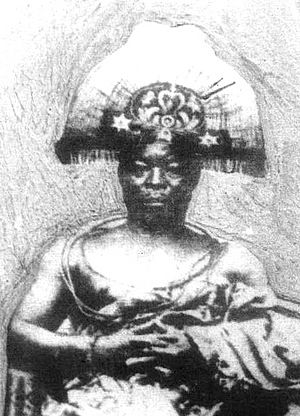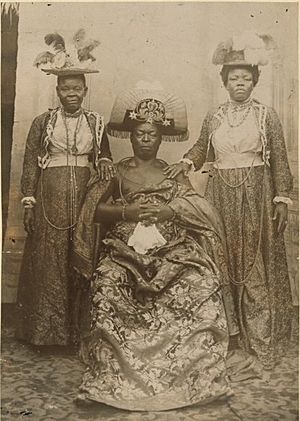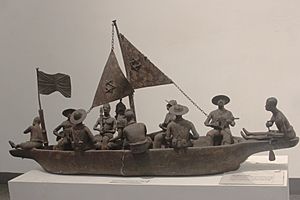Ovonramwen facts for kids
Quick facts for kids Ovonramwen |
|
|---|---|
 |
|
| Reign | 1888–1897 |
| Predecessor | Adolo (r. 1848–1888) |
| Successor | Eweka II |
| Born | c. 1857 |
| Died | 1914 Calabar |
| House | Oranmiyan |
Ovonramwen Nogbaisi (ruled 1888–1897), also called Overami, was the Ọba (king) of the Kingdom of Benin up until the British punitive expedition of 1897.
Born in circa 1857, he was the son of Ọba Adọlọ. He took the name Ovọnramwẹn Nọgbaisi at his enthronement in 1888. Every Ọba took a new name at his coronation, Ovọnramwẹn meaning "The Rising Sun" and Nọgbaisi meaning "which spreads over all".
At the end of the 19th century, the Kingdom of Benin had managed to retain its independence and the Ọba exercised a monopoly over trade which the British found irksome. The territory was coveted by an influential group of investors for its rich natural resources such as palm-oil, rubber and ivory. The kingdom was largely independent of British control, and pressure continued from figures such as Vice-Consul James Robert Phillips and Captain Gallwey (the British vice-Consul of Oil Rivers Protectorate) who were pushing for British annexation of the Benin Empire and the removal of the Ọba.
British invasion
A British invasion force headed by Phillips set out to overthrow the Ọba in 1896. The force's weapons were hidden in baggage, with troops disguised as bearers. Phillips plan was to gain access to Ovonramwen's palace by announcing that he intended to negotiate. Ovonramwen's messengers issued several warnings not to violate Benin territorial sovereignty, claiming he was unable to see Phillips due to ceremonial duties. Having been warned on several further occasions on the way, Phillips sent his stick to the Ọba, a deliberate insult designed to provoke the conflict that would provide an excuse for British annexation. Phillip's expedition was ambushed and all but two were killed. Subsequently, a military operation against Benin in 1897 led by Harry Rawson resulted in the burning of Benin City, the destruction and looting of the royal palaces, and the deaths of untold numbers of its inhabitants. Although the British had orders to hang the Ọba, Ovonramwen escaped, but returned to the city to formally surrender on 5 August 1897. When Ovọnramwẹn returned to the city, after six months spent in evading capture in the forest, he was richly dressed and laden with coral beads and accompanied by an entourage of seven hundred to eight hundred people. He attempted to escape exile by offering Consul General Ralph Moor 200 puncheons (barrels) of oil worth £1500 at that time and to disclose where his 500 ivory tusks were buried (of a value of more than £2M at that time). However, this offer was dismissed as Moor had already discovered them.
Exile
Ovonramwen was exiled to Calabar with two of his wives, Queen Egbe and Queen Aighobahi. He was received and hosted in Calabar in a small town called “Essien Town” by Etinyin Essien Etim Offiong, the progenitor of Essien Town. He died in Calabar around the turn of the new year in 1914. Ovọnramwẹn was eventually buried in the grounds of the royal palace in Benin City. He was succeeded by his first son and legitimate heir, Prince Aguobasimwin, who ruled as Eweka II.



